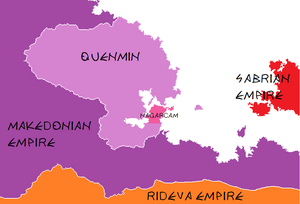Symmerian Quenmin: Difference between revisions
BattlerNonna (talk | contribs) mNo edit summary |
BattlerNonna (talk | contribs) mNo edit summary |
||
| Line 10: | Line 10: | ||
The Makedonians retained the governmental structure of the Quảng Dynasty, known as the Ten Ministries. Quenmin was the site of significant Hellenic colonization across the country, resulting in a Hellene Quenminese population that persists to the modern era. The Ten Ministries also adopted the Hellenic alphabet, where it became known as the ''Chữ Hy Lạp''. As a major trade hub for maritime trade routes from [[Cacerta]] and Eracura, many cities in Quenmin grew to be wealthy urban centers of art and culture. Quenminese soldiers and bureaucrats were widely employed throughout the Empire during the duration of its existence. | The Makedonians retained the governmental structure of the Quảng Dynasty, known as the Ten Ministries. Quenmin was the site of significant Hellenic colonization across the country, resulting in a Hellene Quenminese population that persists to the modern era. The Ten Ministries also adopted the Hellenic alphabet, where it became known as the ''Chữ Hy Lạp''. As a major trade hub for maritime trade routes from [[Cacerta]] and Eracura, many cities in Quenmin grew to be wealthy urban centers of art and culture. Quenminese soldiers and bureaucrats were widely employed throughout the Empire during the duration of its existence. | ||
The outset of the [[Burning Plague]] less than 150 years after the conquest of Quenmin paved the way for Tieu Sisters' Rebellion. Taking advantage of the depleted state of the [[Ancient Makedonian army]], the Tieu Sisters succeeded in establishing an independent kingdom with control of around 40% of Quenmin before Makedonian reinforcements crushed the rebellion in a bloody six year long conflict. Makedonian control over Quenmin continued to decline afterwards, eventually culminating in the [[Autumn Flag Rebellions]] in | The outset of the [[Burning Plague]] less than 150 years after the conquest of Quenmin paved the way for Tieu Sisters' Rebellion. Taking advantage of the depleted state of the [[Ancient Makedonian army]], the Tieu Sisters succeeded in establishing an independent kingdom with control of around 40% of Quenmin before Makedonian reinforcements crushed the rebellion in a bloody six year long conflict. Makedonian control over Quenmin continued to decline afterwards, eventually culminating in the [[Autumn Flag Rebellions]] in 1063, which ended in the overthrow of Makedonian rule by 1077, costing the Empire most of its holdings in eastern Siduri. | ||
[[Category:Ancient Syara]] | [[Category:Ancient Syara]] | ||
Latest revision as of 06:28, 2 February 2023
Part of a series on the |
|---|
| History of Quenmin |
 |
Makedonian Quenmin refers to the history of Quenmin when it existed under the control of the Makedonian Empire.
Following the conquest of Serikos in the 6th Century CE, the Makedonian Empire sought to expand further east into the lands of Quenmin. Shortly after coming to power in 635 CE, Deinokrates III sought to invade Quenmin and began making military preparations for the conquest of the country. The invasion began in 638 CE with an army numbering several hundred thousand strong, composed of soldiers from Syara, Ruvelka, Mansuriyyah, Bosrei, Arkoenn, and Serikos. After the grueling and extended conquest of Serikos the previous century, Makedonian expectations for a protracted struggle were proven incorrect owing to the Second Quenminese Anarchy, which prevented the Quảng Dynasty from effectively resisting the Makedonians. While several warlord states and powers attempted to form a power bloc to resist the Empire, this was not enough to surmount the superior manpower and resources of Makedon, further offset by the defection of several prominent Quenminese warlords that accepted Makedonian rule in exchange for clemency.
The Makedonian conquest brought the Makedonians into direct contact with the Sabrian Empire. The Sabrians had long maintained a presence in Quenmin and were allies of the Kingdom of Nagarcam, located in present day Lào Hòa and Nảy Thịt. Makedonian intentions to annex Nagarcam led to the outbreak of the First Sabrian War, the beginning of the decades long Sabrian Wars. The five year conflict ended with the Sabrians driven from Quenmin, granting the Makedonians dominion over the country. Quenminese levys and mercenaries saw extensive service in the first conflict, so much so that it was sometimes called the "Quenminese War"; Quenminese troops continued to be employed by the Makedonians during the Second Sabrian War.
The Makedonians retained the governmental structure of the Quảng Dynasty, known as the Ten Ministries. Quenmin was the site of significant Hellenic colonization across the country, resulting in a Hellene Quenminese population that persists to the modern era. The Ten Ministries also adopted the Hellenic alphabet, where it became known as the Chữ Hy Lạp. As a major trade hub for maritime trade routes from Cacerta and Eracura, many cities in Quenmin grew to be wealthy urban centers of art and culture. Quenminese soldiers and bureaucrats were widely employed throughout the Empire during the duration of its existence.
The outset of the Burning Plague less than 150 years after the conquest of Quenmin paved the way for Tieu Sisters' Rebellion. Taking advantage of the depleted state of the Ancient Makedonian army, the Tieu Sisters succeeded in establishing an independent kingdom with control of around 40% of Quenmin before Makedonian reinforcements crushed the rebellion in a bloody six year long conflict. Makedonian control over Quenmin continued to decline afterwards, eventually culminating in the Autumn Flag Rebellions in 1063, which ended in the overthrow of Makedonian rule by 1077, costing the Empire most of its holdings in eastern Siduri.
